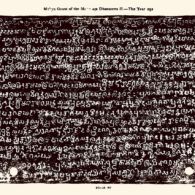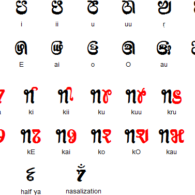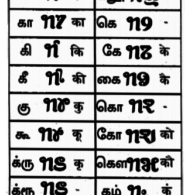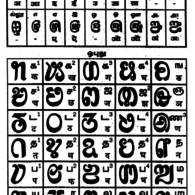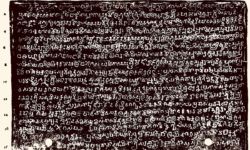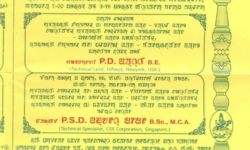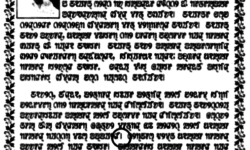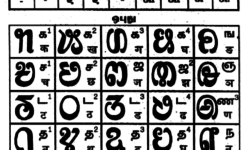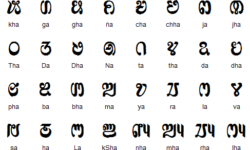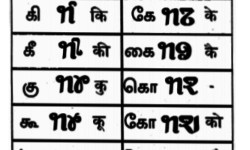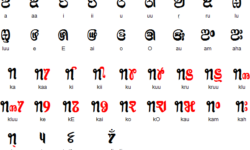Profile
The story of the Sourashtra script begins, in a sense, in Japan.In the 1980s Norihiko Ucida, a Japanese scholar, went to Madurai, in southern India, to research Sourashtran — something of an island of a language, as the Sourashtrians originated in Gujarat but migrated to the Madurai area, in Tamil Nadu, where (not surprisingly) they were surrounded by Tamils, whose languages derive from an entirely different language family.
He learned Sourashtran well enough to compile the first Sourashtra-English dictionary, published in 1990, and wrote: “Sourashtrans had their own beautiful and systematic script, the origin of which is not known. At the end of the last century T. M. Rama Ra[i] reformed the script and cast types for it. He published many books in this script. Later he introduced some changes and standardized it, [producing a version that] is now used by some people as Sourashtra script. Since the end of the nineteenth century books have been printed in Telugu, Tamil, Devanagari and Sourashtra scripts. When Gandhiji preached for one common script for India, one group of the community decided to abandon the Sourashtra script in favour of Devanagari and destroyed the matrix designed by Rama Ra[i].”
(Rama Rai’s achievement was held in such regard that even today the Sourashtran script is sometimes called Ramarai in his honor.)
The move toward centralization and unification of languages in India, which to some extent had begun under colonial rule, gathered force immediately before and after independence. Between the wars, a resolution was passed to adopt the Devanagari script for the Sourashtra language. When the case for teaching Sourashtran in schools was presented to the state’s Commissioner for Linguistic Minorities in 1964, who had been sent a copy of a book in Sourashtran, the Commissioner seems to have come up with a Catch-22 argument: as he had been sent only one book for scrutiny, there was no point in examining the merits of the issue. The question of printing textbooks in Sourashtran would have to wait until a large number of books was available for examination.
The point was, Sourashtra did not fit in. Devanagari needed at least seven extra characters to represent the full range of the Sourashtran spoken language, and for some it also epitomized the authority of the voice of government up in Delhi. Tamil (which most Sourashtrans speak to a virtually bilingual degree) worked up to a point, but only when a number of superscript marks were added.
With the new millennium, though, the tide changed. Even though, as is the case with language communities all over the world, the Saurashtra community is conflicted (Devanagari or Tamil or Sourashtran? Ancient or modern? Global or local?) a series of journals and other publications have appeared in the script.
In 2007 a former Sanskrit Professor of Sourashtra College in Madurai, T.R. Damodaran, won the Sahitya Akademi’s Bhasha Samman Award for Sourashtra language for his book Jiva Sabda Kosam, a compilation of 1,333 Sourashtra words with English and Tamil meanings compiled with help from the Central Institute for Indian Languages.
S. Saroja Sundararajan was named co-winner of the award for her poetry and translations, and won a special prize for “the contribution of authors writing in unrecognized languages of India.”
Even though Sourashtran is an unofficial script, not taught in schools by the government of Tamil Nadu, it seems to be gaining traction through independent channels. Groups such as Sourashtra Vidya Peetam are teaching Sourashtra through Facebook, and an online newspaper appears in Sourashtran and Tamil. Most recently, digitized fonts have been created locally, and mobile-friendly applications.
“When a government promotes a language and its script as the official script of a region, it naturally gains wide currency as all day-to-day and official communication takes place in that script,” explained Govardanan Laguduva, a former professor at Sourashtra College in Madurai. “An inevitable consequence of this governmental promotion is the loss of `utilitarian value’ felt by the majority of the people using their own script till then.
“However, a minority of the mother-tongue lovers who strive to retain their linguistic and scriptural identity think beyond such utilitarian values and take earnest efforts to promote their language and script at all costs. This is what is happening in regard to Sourashtri script. Sourashtri language and script lovers learn it passionately and seek to spread its use without banking upon governmental support.”
Update February 2024
reports that several local institutions are now supporting the script. “Sourashtri Sahitya Sadas, Madurai and Sourashtra Bhasha Viruddhi Mandal, Tanjore both jointly teach Saurashtri in Sourashtri script and Salem Sourashtra teachers training centre also teaches Sourashtri in Sourashtri script. Students apear for certicate course conducted by Saurashtra University. This year 115 students wrote certificate examination on May 26th. On July 29th convocation is to be held in Tanjore in a grand manner. Dr. Kamalesh Joshipuraji Former V. C. of Saurashtra University participates with Dr. Ravi Zala.
“The following organisations teach Sourashtri in Sourashtri script and prepare the students for certificate course Yuva Bharati conducted by Saurashtra University.
- Sourashtri Sahitya Sadas, Madurai
- Sourashtra Bhasha Viruddhi Mandal, Tanjore
- Sourashtra teacher training centre, Salem.”
You can help support our research, education and advocacy work. Please consider making a donation today.
Links
General Script, Language, and Culture Resources
- Omniglot
- Wikipedia
- Unicode (PDF)
- Learning App for Sourashtra Language
- Sourashtra Language Lessons – Vowels
- Sourashtra Language Lessons – Consonants
- Sourashtra Language, Region, Culture, and Community Article
- Scriptsource
- Sourashtra Script Exercise Book
- Sourashtra TV App
Community Resources
- Sourashtra PalkarPillonu Facebook
- Sourashtra Bhasha Facebook
- New Life Short Film Sourashtra Language
- Voice of Sourashtrians
- Sourashtra Madhya Sabha Friends (Facebook)
- Sourashtra Time Readers (Facebook)
